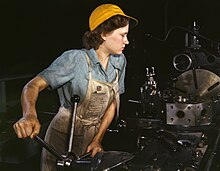Machinist
A machinist is a person who uses tools to make modify parts and objects, such as parts for firearms, vehicles such as airplanes, cars, and boats, and plastic injection molds. A machinist can cut metal, plastic, wood, or other materials, such as ice. Machinists may operate manual machines or Numerical control (CNC) machines.

Machinists follow a print that tells them what kind of metal to use, where to cut, how deep to cut, what angles to cut at, and many other specified instructions to meet a person's standards.
Machines
changeThese tools include, but are not limited to, the:
- Lathe, a machine tool that grips a piece of "stock" (metal cut into a smaller size for machining) and spins it against cutting point. A lathe may be CNC or manual.
- Milling machine, a machine tool that grips a cutter and spins it, and allows the stock to be pushed into, away from, or against the cutter. A milling machine may be CNC or manual.
Tools
changeMachinists will make use of calipers, gages, micrometers, paints, and other items for the use of checking to see if parts are machined correctly or planning out cuts.
Layout paint may come in red or blue. It is used to coat the side of a part for scribing a path or shape of a cut.
Bar stock
changeBar stock is metal that has not yet been machined. It may be referred to as slugs, blanks, or billets. It may be made of different kinds of steel or aluminum.
Metals higher in Carbon are harder to cut, while metals lower in carbon are easier to cut.